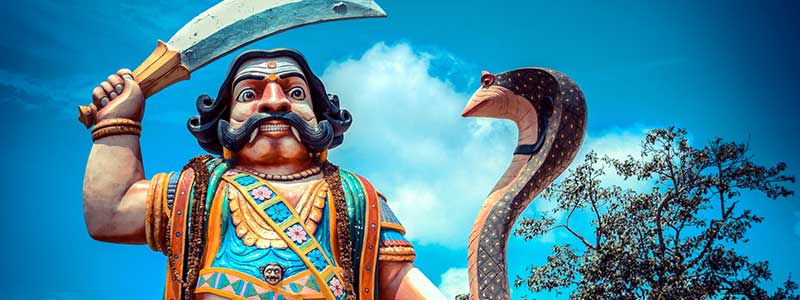
Meet the Asuras who celebrate Mahishasura's Martyrdom
- Satyarthi Mishra
- Nov 1, 2020
- 3 min read
Updated: Oct 3, 2021
Every year, when the state of West Bengal, particularly Kolkata, gets adorned in dazzling lights to celebrate Durga's homecoming, the goddess who had slain Mahishasur, a tribal community in eastern India mourns their king's death.
From Mahalaya onwards, rejoicing the triumph of good over evil, people welcome the goddess Durga and her children home and celebrate it with grandeur and glory. During Durga Pujo, the 10-day annual festival in Bengal, the city celebrates divine femininity. According to the subaltern version of the myth, Mahishasur, the buffalo-tribal king, was deceived and stabbed by Durga because of a boon that no man could defeat him. Subsequently, a group of gods arrived and killed him.
Asurs, a 'particularly vulnerable tribal group', dominates Sakhuapani's population of about 2,000 and lives in villages spread over a radius of 10 to 20 km. The Asurs claim to be descendants of Mahishasur, the buffalo-demon whom Goddess Durga kills after a spirited fight lasting nine nights.
"Mahishasur has been revered as a hero traditionally by Santhals in West Bengal. We have been opposing how Mahishasur is portrayed in Durga Pujo, where he is depicted kneeling before Durga who kills him. Unfortunately, Mahishasur is considered a demon and a mythological character when he was a hero who fought bravely against invaders, the Aryans," Nityananda Hembram, the head of the Bharat Jakat Majhi Madowa, a Santhal organization told Indo-Asian News Service.
Thus, the Asur community assembles on a full-moon night of the Hindu calendar month Ashwin to mourn Mahishasura's death. The Asur Pujo is observed twice a year, once during the month of Phagun (March) and again during the month of Ashwin (September-October), which coincides with the tenth day of Durga Pujo (Dashami/ Dusshera).
However, the tradition of Asur Pujo has spread into several other tribal villages in Bengal. Tribal and Dalit communities such as Bagdi, Santhals, Mundas, and even Namasudras commemorate the martyrdom of Mahishasura.
Vandana Tete from the Jharkhandi Bhasha Sahitya Sanskriti Akhra, an organization involved in reviving tribal history and their way of life, told the legend of Mahishasur finds its echoes even in the folklore of the Santhals, numerically the most prominent tribal group, spread across Jharkhand and West Bengal. When others celebrate Navratri, the Santhals look for their missing chief, 'Hudur Durga'. When they cannot find him, they pretend to dismantle a clay model presented through a dance form. Many academics have interpreted this as the Santhals seeking Mahishasur, who, they believe, was killed by deceit.
Hundreds of kilometers away from Jharkhand's Sakhuapani village in West Bengal's Jalpaiguri district is Carron tea estate. Here, down a hillock carpeted with emerald-green tea bushes, lives Bargi Asur, 86, with his family. Reading a Hindi newspaper in his house's courtyard, Bargi introduces himself as the "senior-most resident" of 'Asur Line', a colony of about 100 mud and bamboo huts in the tea estate. For centuries, they have been afraid to speak openly about their ancestry. Now they perform their rituals almost apologetically, said Bargi, whose son and grandchildren converted to Christianity a few years ago.
Bargi belongs to a group of 1,000 Asurs, who migrated from Jharkhand and Madhya Pradesh in the early 20th century to work and live near Jalpaiguri's tea gardens. In 1914, his father moved there to work for a British tea planter. Ever since they have been living there for more than a century now, he added.
Jagannath Singh, 70, a social worker who used to be a primary school teacher at the Carron tea estate school, said the story of the Asurs is like that of most other' particularly vulnerable tribal groups', but with a "cruel twist of fate". Apart from abject poverty, they also need to tackle social stigma. After years of struggle, only in 2014 were the Asurs in Jalpaiguri recognized as a Scheduled Tribe, informed Singh. He said that of the 101 Asur families living in Carron tea estate, more than 90 have converted to Christianity. Having little choice, they feel this new identity can offer them a better life.
Over the past few years, the Asura Pujo has become an integral part of the Dalit-Bahujan discourse, where activists claim it is one way for Dalits to reclaim public spaces and their neglected identities in the context of Durga Pujo. Traditionally, the Durga Pujo celebrations had been a Savarna affair, usually restricted to Zamindar families in pre-Independence Bengal. But in the 18th century, 12 people assembled on the Hooghly and brought the festival into the public domain by organizing the first community Pujo (known as Baroaari Pujo).
Over the years, the Asurs of both Jalpaiguri and Sakhuapani in Jharkhand have migrated to cities searching for jobs. Most youngsters do not speak the Asuri language anymore; their worries are 'mainstream' as any other. The only thing they hold on to is memories — of stories told by their parents, childhood fears, and anxieties.






Comments